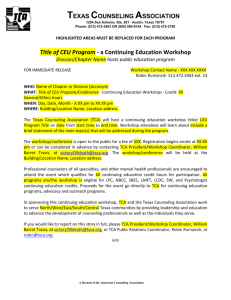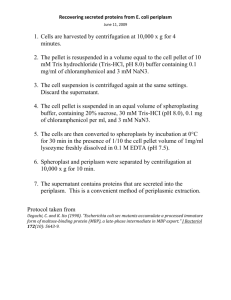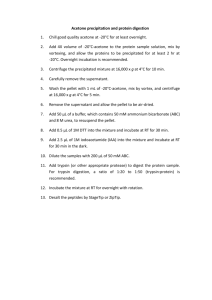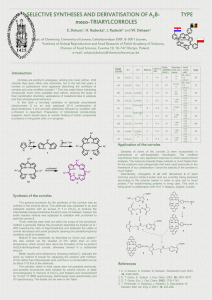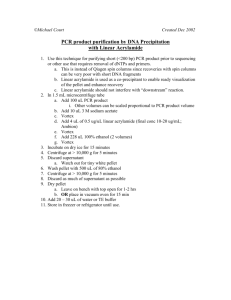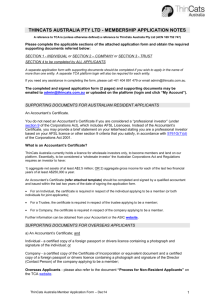TCA precipitation
advertisement
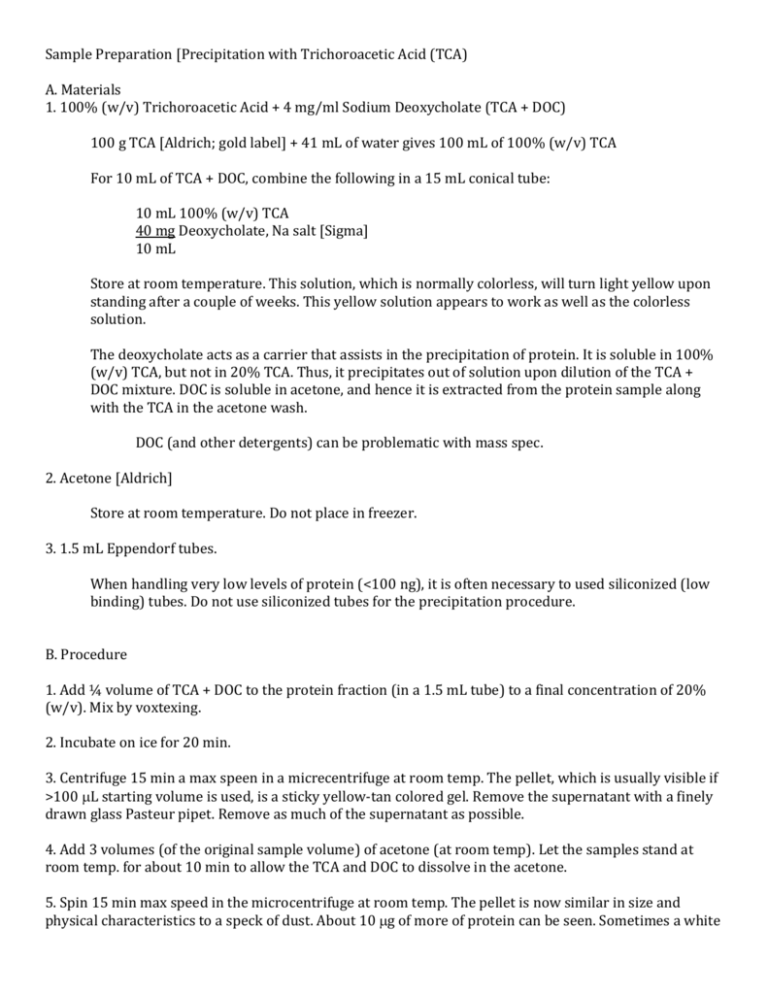
Sample Preparation [Precipitation with Trichoroacetic Acid (TCA) A. Materials 1. 100% (w/v) Trichoroacetic Acid + 4 mg/ml Sodium Deoxycholate (TCA + DOC) 100 g TCA [Aldrich; gold label] + 41 mL of water gives 100 mL of 100% (w/v) TCA For 10 mL of TCA + DOC, combine the following in a 15 mL conical tube: 10 mL 100% (w/v) TCA 40 mg Deoxycholate, Na salt [Sigma] 10 mL Store at room temperature. This solution, which is normally colorless, will turn light yellow upon standing after a couple of weeks. This yellow solution appears to work as well as the colorless solution. The deoxycholate acts as a carrier that assists in the precipitation of protein. It is soluble in 100% (w/v) TCA, but not in 20% TCA. Thus, it precipitates out of solution upon dilution of the TCA + DOC mixture. DOC is soluble in acetone, and hence it is extracted from the protein sample along with the TCA in the acetone wash. DOC (and other detergents) can be problematic with mass spec. 2. Acetone [Aldrich] Store at room temperature. Do not place in freezer. 3. 1.5 mL Eppendorf tubes. When handling very low levels of protein (<100 ng), it is often necessary to used siliconized (low binding) tubes. Do not use siliconized tubes for the precipitation procedure. B. Procedure 1. Add ¼ volume of TCA + DOC to the protein fraction (in a 1.5 mL tube) to a final concentration of 20% (w/v). Mix by voxtexing. 2. Incubate on ice for 20 min. 3. Centrifuge 15 min a max speen in a micrecentrifuge at room temp. The pellet, which is usually visible if >100 L starting volume is used, is a sticky yellow-tan colored gel. Remove the supernatant with a finely drawn glass Pasteur pipet. Remove as much of the supernatant as possible. 4. Add 3 volumes (of the original sample volume) of acetone (at room temp). Let the samples stand at room temp. for about 10 min to allow the TCA and DOC to dissolve in the acetone. 5. Spin 15 min max speed in the microcentrifuge at room temp. The pellet is now similar in size and physical characteristics to a speck of dust. About 10 g of more of protein can be seen. Sometimes a white pellet of salt (KCl, etc.) is obtained. Remove the supernatant with a very finely drawn Pasteur pipet. Let the pellet dry for 10 min on ice (leave the cap of the 1.5 mL Eppendorf tube open). **The pellet can be stored at this point at -20C indefinitely 6. Dissolve the pellet in 1X SDS Sample buffer + 2-mercaptoethanol (I use 6 mL with the BioRad MiniGel apparatus). If a small residue of TCA remains, the bromophenol blue will turn yellow. Unless your technique is really egregious and there is a ton of TCA, the yellow samples will be just as good as the normal blue samples (i.e., the gel lanes from yellow and blue samples will look the same…the gel buffer will take care of it). If there is a residue of KCl in the pellet, a flocculent white precipitate (potassium dodecyl sulfate) will form upon addition of 1X sample buffer to the precipitated protein. This can make it somewhat difficult to load the samples, but once in the lane properly they should run well. 7. Incubate the samples at 95C for 2 min, then spin 10 sec in a microcentrifuge to pellet all the liquid. Load the gel.

